#crocodilian facts
Explore tagged Tumblr posts
Note
Hi, Atticus! Question first: Do you know anything about tomistoma? I'm a huge reptile fan, but I'd never heard of them until recently; I'd love to hear anything you know about them :) Anecdote and praise second: I LOVE YOUR BLOG! I check it literally every day to see what new, cool stuff you've shared. I recently went to the Smithsonian National Zoo, and when I walked through their Reptile House, I checked all of their enclosures for the stuff you mention in your posts :) They seemed great!
Yeah, the Smithsonian zoo is a national leader! I had the opportunity to work with Murphy, one of their komodo dragons, as part of an event for PhD-persuing herpetologists and it was a wonderful experience. I love visiting their zoo and catching up with their keepers every time I'm in the area.
Now...tomistoma!! These funky little freshwater crocodilians are so mysterious and cool.

If you know anything about crocodilians, you're probably looking at that snout and thinking "okay, so these guys eat almost exclusively fish, right?" WRONG! They're actually generalists and will eat anything that comes their way.
The long narrow snout is great for catching fish, yeah. But it's probably because they're very closely related to gharials (they're called false gharials in some areas!). The snout is probably a gharial trait, and tomistoma snouts actually widen near the base - probably they've kept the long snout for fish, and then widened it to catch everything else.
Tomistoma might have the largest eggs of any extant crocodilians!
Tomistoma are unfortunately endangered and threatened with extinction throughout much of their range. You can help by raising awareness about these awesome crocodilians, speaking up against drainage of freshwater swamplands, and avoiding purchasing any crocodilian-skin products.
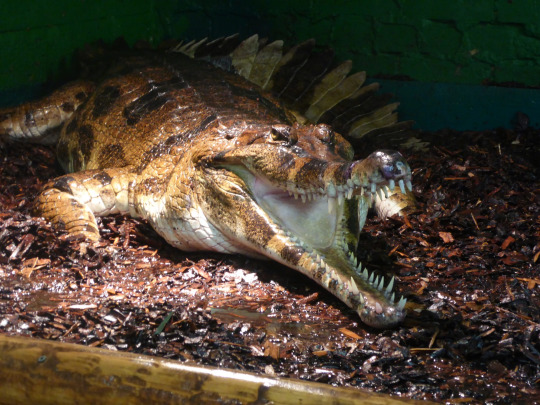
190 notes
·
View notes
Text
Uncharismatic Fact of the Day
The best way to an alligator's heart is through its stomach-- literally! Alligators have a four-chambered heart, just like mammals. But they can chose to shunt one of their aortas, instead sending deoxygenated blood straight to their stomach where it is converted into gastric acid. Scientists believe this process may help with digestion after a large meal.

(Image: An American Alligator (Alligator mississippiensis) by Steve Hillebrand)
If you like what I do, consider buying me a ko-fi!
372 notes
·
View notes
Text
Monday Musings: Diapsida
One of the largest groups of vertebrates are the diapsids (two pairs of temporal fenestrae in the skull). Diapsids are nested in the larger clade sauropsida (reptiles, their ancestors and all their descendents).

The arrangement of the extra skull holes allows for bigger, stronger jaw muscles and enables the jaw to open wider.

A lesser ancestral characteristic is that of a long radius compared to the humerus.

Traditionally, diapsids were just modern reptiles and not their extinct relatives. In 1991, Laurin defined diapsida as "the most recent common ancestor of araeoscelidians, lepidosaurs, archosaurs and all their descendents. What does that mean to the non-scientist? Let's break it down.

Araeoscelidians were small lizard-like animals that lived in the Late Paleozoic Era. Often, this group is considered a sister group to diapsida but some do put them in the clade. They have slender legs, elongated tails and the two temporal fenestrae in their skulls.

Lepidosaurs are much better known by the lay person. This group includes all snakes, lizards and even the tuatara. Lepidosauria can be further split into two groups: squamata (lizards and snakes) and rhynchocephalia (tuatara is the only living member). Characteristics of lepidosauria include more flexible skulls (especially in squamates), the ability to self-amputate their tails (lost in some species_) and horny (keratinized) scales that make up the epidermis.
Other famous lepidosaurs include mosasaurs.

Archosaurs are also a fairly familiar group. Living members of this clade include crocodilians and birds.

The most famous members of this clade are probably the dinosaurs.

Archosaurs first appeared in the Triassic Period. Characteristics of the group include teeth set in deep sockets, mandibular fenestrae (hole in the mandible)

and a pronounced fourth trochanter (ridge on the femur where muscles attach),

Archosaurs move with an erect or semi-erect gait.

Recent phylogenetic studies place turtles somewhere between lepidosaurs and archosaurs with a common ancestor closer to archosaurs than lepidosaurs which makes them euryapsids, diapsids who secondarily lost their temporal fenestrae.
Now you know a little bit more about diapsids! Tune in tomorrow for some trivia!
#paleontology#fossils#dinosaur#fun facts#science#paleontologist#diapsida#lizards#snakes#tuatara#turtles#birds#crocodilians#science education#science terminology
22 notes
·
View notes
Text




eepy
#me#who nappin with me#i should be sleeping rn#instead im posting about the fact im sleepy :3#silly#silly spinny#crocodile kin#croc kin#crocodile#crocodilian#alterhuman#therian#nonhuman#spinny silly posting#IT'S LIKE 10 MINS TILL SLEEPY CRITTER SUNDAY LET ME HAVE THIS#sleepy critter sunday#reptile kin#lizard kin
21 notes
·
View notes
Text
Probably not very accurate, but this is my favorite reconstruction of Terrestrisuchus, a land crocodile from the Triassic

I've been obssesed with this *design* ever since I was a kid. We COULD have little crocokitties but we were robbed.

#cosas mias#terrestrial crocodiles were A LOT more common than most people know#in fact the whole idea that crocodiles didn't really change is only true for semi-aquatic species#terrestrial crocodilians were incredibly weird and in lots of shapes#crocodiles#paleontology#triassic
50 notes
·
View notes
Text
Wet Beast Wednesday: Nile crocodile
Humans in general often have a fear of large reptiles. This may have an evolutionary advantage as it helped our smaller ancestors avoid large predators like snakes and crocodiles. Whatever the reason, the fear has entered into many belief systems and one common feature in many myths, legends, and religions of Africa and the Middle East is the Nile crocodile. While their reputation as man-eaters is somewhat exaggerated, Nile crocs are one of the most dangerous reptiles to humans, with only the saltwater crocodile matching them in human deaths. However, like most animals, the danger can be avoided if you know what to do and what not to do.
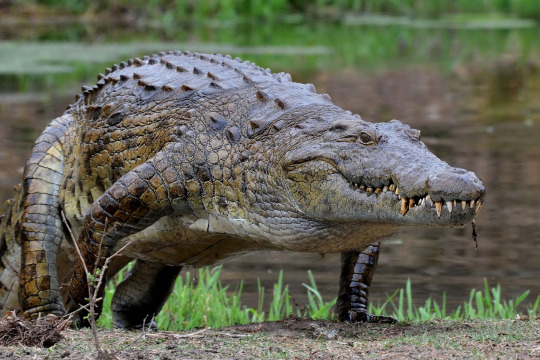
(Image ID: a Nile crocodile walking on land, seen from the front. It is a quadruped with short limbs on the side of its body, scaly skin, and an elongated set of jaws with protruding teeth. The tail is out of view. Its body is dark brown on top and yellowish on the sides. End ID)
The Nile crocodile, Crocodylus niloticus, is the second largest crocodilian and (depending on how you measure some snakes) possibly the second largest living reptile after the saltwater crocodile. Average adult males (which are larger than females) reach between 3.5 and 5 meters (11.5 to 16.5 ft) and and 255 to 270 kg (500 to 1,650 lbs), but some specimens have gotten considerably larger, with the largest confirmed size on record being a male who broke the scale at 6.45 m (21 ft) and between 1,043 and 1,089 kg (2,300 - 2,400 lbs). Nile crocodiles are fairly typical crocodilians. They are large quadrupeds with scaly skin covered with scutes and osteoderms, long and powerful jaws, and eyes, ears, and nostrils on top of their heads. Their eyes are protected with transparent eyelids called nictitating membranes and their skin has many sense organs whose purpose is poorly understood but may help detect changes in water pressure. While on land, the crocodiles are fairly slow and ungainly, but they can swim at high speeds when needed. The broad jaws and powerful muscles give the crocodiles an enormous bite force, being able to bite down on prey with 22 kilonewtons of force. For comparison, humans max out at about 0.7 kilonewtons. This force can also be continuously applies for long periods of time, allowing the crocodiles to hold struggling prey in their mouth and drag it underwater. Famously, though crocodilians can close their jaws with incredible force, the muscles for opening their jaws are much weaker and can be held shut with a person's bare hands or some duct tape. They have dark bronze scales on the back and lighter yellow scales on the sides and underbelly, marked with dark spots. The color darkens as the animal ages. As with all crocodilians, the Nile crocodile has a four-chambered heart that is highly efficient at oxygenating blood and is similar to the hearts of birds. Crocodilians and birds are actually more closely related to each other than they are to anything else still alive. All crocodilians have high lactic acid levels in their blood. This allows them to sit motionless for long periods of time, but increased levels due to overexertion can kill them.

(Image ID: a Nile crocodile resting in the water just offshore, with most of its body still visible. This one is a lighter brown. Its tail is visible. It is long and thick, with two rows of scutes running down it. Its mouth is open. End ID)
Nile crocodiles are found throughout a large portion of Africa and are the most widespread crocodiles, with only the saltwater crocodile having a wider distribution. Their current range is smaller than it used to be and now it is known that areas there were once thought to be part of the Nile croc's range are actually home to the similar species known as the West African crocodile. The West African crocodile was formerly believed to be the same species as the Nile crocodile and was only reclassified in 2011. Their habitat is freshwater lakes, waterways, and swamps throughout Africa. They can tolerate brackish or marine water, but but prefer fresh water. Like other crocodilians, Nile crocs are largely sedentary ambush predators. They can remain motionless for long periods of time, often submerged with only their eyes, ears, and nostrils exposed. A crocodile submerged like this can easily be mistaken for a log. When prey comes close, the crocodile will lunge forward and bite down. Larger prey that is not killed outright will be dragged into the water and drowned. Almost uniquely among crocodilians, nile crocodiles are known to hunt on land. They still employ ambush tactics, usually hiding in brush along paths at night and attacking animals passing by. They have even been known to try to steal kills from land predators and get into tug-of-war battles with lions over pieces of carrion. While clips of a massive crocodile leaping out of the water to drag a zebra to its doom make for entertaining documentaries, about 70% of a Nile crocodile's diet is composed of fish. As an individual grows, larger land animals will make up more of its diet. Nile crocs have been known to cooperate to herd fish into tight spots where they are easier to catch and eat. While famous for their skill and hunting and killing prey, Nile crocodiles are anything but voracious eaters. Their stomachs are pretty small for their size, only around the volume of a basketball. They can also go long periods of time between meals, sometimes several months without signs of starvation. Nile crocodiles are a classic case of apex predators. An adult Nile crocodile has no natural predators, though young ones do get attacked and eaten by larger predators, including other crocodiles. Curiously, they are known to swallow stones. Swallowing stones, known as gastroliths, it a well-known behavior in the animal kingdom. They are usually held in the digestive tract and used to help grind up tough food. Most species that use gastroliths are herbivores or omnivores who use them to help grind up tough plant matter, so it's not clear why the carnivorous crocodiles need gastroliths.

(Image ID: a nile crocodile's had visible above water. Its mouth is open and in it is a silvery fish known as a tilapia. End ID)
youtube
(Video ID: a clip from the BBC Earth showing a Nile crocodile successfully attacking a wildebeest. End ID)
When not attacking prey, Nile crocs are pretty sedentary. They can easily spend most of the day basking in the sun, behavior common to large reptiles who need a long time in the heat to warm their bodies enough to perform daily functions. While basking, they sit on land, often with their mouths open. The open mouths are vital for thermoregulation (a crocodile with its mouth sealed shut can overheat and die), but may also serve as a warning to others who may want to steal their spot. In the southernmost reach of their range, Nile crocodiles may wait out the cool, dry months of May to August by digging burrows and entering aestivation, a state similar to hibernation. Nile crocodiles are social creatures that live, bask, and hunt together. They follow a social order with the largest individual around (almost always an old male) being in charge and having first access to food and the best territory. Males are territorial and will try to force other males out of their range. Larger males will be able to maintain the best territories while smaller males are forced to live on the outskirts. Females are not territorial and will seek out the best male territories to live in. While territorial, crocs of all sizes will come together while basking and their interaction then are mostly peaceful. they are known to communicate through posturing, touch, and vocalizations. Males are known to compete over territory and while most of these competitions are settled through threat displays, they may escalate to violence.

(Image ID: four crocodiles resting on a sandy shoreline. End ID)
Territoriality is especially prominent during mating. The mating season begins around the beginning of the dry season and varies based on location. Males will signal for females with several noises, including bellowing, blowing water out of their noses, and slapping the water with their heads. Males will also attempt to drive other males away to reduce competition. When a female chooses a male, she will approach him and the pair rub their jaws together while making a warbling sound. Males like it rough, roaring and pining the females down, sometimes underwater, while mating. Most males will only mate with a single female each year, though some particularly successful males in certain regions will can multiple mates each year. After two months, the female lays her eggs. While most crocodilians incubate their eggs in piles of rotting leaves, Nile crocodiles use sandy banks or beaches. The female digs a nest, lays up to 80 eggs in it, then buries the eggs. The heat of the sun is used to incubate the eggs and to determine the sex of the offspring. Eggs incubated between 31.7 and 34.5 degrees C will be male. All others will be female. Nests used to be laid extremely close to each other, but but to increased disturbances along the nesting sites, this has become rare. During the incubation period, the mother guards the nest continuously, only leaving to avoid overheating by resting in the shade or entering the water. The father also plays a role, patrolling the area around the nest to drive away predators who would eat the eggs. Incubation lasts about 90 days and the female usually will not eat during this time. The hatchlings will make chirping noises before hatching to signal to the mother that she needs to dig out the nest. Once uncovered, the mother may use her jaws to crack the eggs and assist hatching. Hatchings start at around 280 mm (11 in) long and 70 grams (2.5 oz) and will increase by that rate for the first few years. The mother will protect her offspring for up to two years, often carrying them on her back or in her mouth or throat pouch to keep them safe from predators. The juveniles feed on insects for the first few years of life. Even after leaving their mother, hatchlings will often live in groups until they are large enough to not have to worry about predators. It is estimated that only 10% of eggs hatch and 1% of hatchlings survive to adulthood. Sexual maturity is reached at around 11 to 12 years and the maximum lifespan is estimated to be 70 to 100 years.
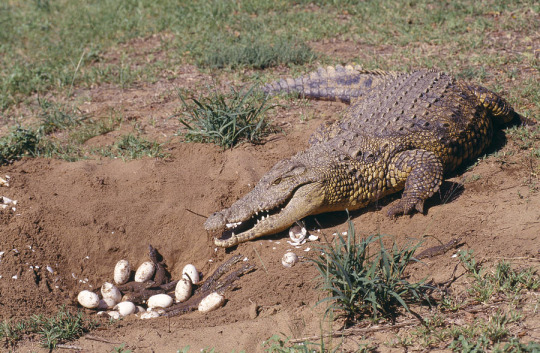
(Image ID: a Nile crocodile mother standing at the edge of her nest, a pit in the ground. Multiple white eggs are visible, as are newly-hatched crocodiles, which are far smaller version of an adult. End ID)
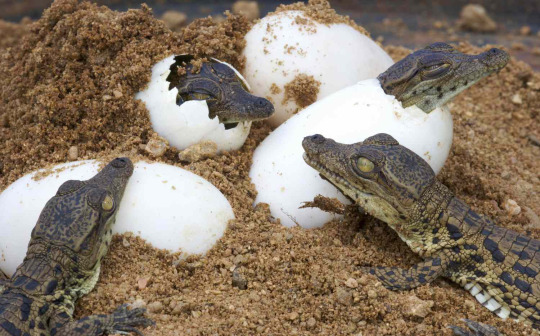
(Image ID: Nile crocodile eggs hatching. Four eggs are visible and two are actively hatching, with only the hatchling's heads having emerged. Two other crocodiles have already hatched. End ID)
Nile crocodiles are threatened by habitat loss, pollution, prey loss, bycatch, and human hunting. From the 1940s to the 60s, Nile crocodiles were hunted in massive numbers for the leather trade and were near extinction until new laws, international trade regulations, and conservation efforts largely stopped the hunting efforts. Despite this, their population has not returned to pre-hunting levels and they have been extirpated from many locations. Poaching still happens, as does hunting due to their perceived status as man-eaters, which is actively hindering conservation efforts. Like with sharks, the public image of an animal as being dangerous to humans directly harms its survivability and conservation efforts. Loss of habitat and suitable nesting sites due to damming and other human-caused changes to wetlands have also damaged crocodile populations. An invasive plant, Chromolaena odorata, is harming the crocodiles due to it growing out of control in nesting grounds. The shade from the plants keeps the sun from warming the eggs, causing them to die. Nile crocodiles and saltwater crocodiles are responsible fro the vast majority of attacks on humans and it is estimated that Nile crocs may be responsible for hundreds of deaths (most of them unreported) a year. Only the largest individuals pose a threat to adult humans, though children are at risk to smaller crocs. In fact, Nile crocodiles kill more humans per year through direct attacks than any other wild animal. Those numbers are still dwarfed by deaths due to disease spreading animals, animals acting in self-defense, or attacks or injuries from domesticated animals. For the most part, the crocodiles do not seem to target humans, the number of attacks comes from humans and the crocodiles both living near the water's edge and the crocodiles' nature as generalist predators of large animals. People who study and interact with the crocodiles report that if the right precautions are taken, the danger from being around the animals is negligible and many people and groups have tried to spread safety precautions, especially to poor and remote areas where attacks are likely the most common.

(Image ID: several juvenile Nile crocodiles in a tank being fed. Someone is using a grabber on a stick to drop meat into the tank. Four of the crocodiles are rearing out of the water to get the food. End ID)
#wet beast wednesday#nile crocodile#crocodile#crocodilian#africa#reptile#freshwater biology#freshwater ecology#biology#zoology#ecology#images#image described#cw mentions of death#animal attack#animal facts#Youtube
33 notes
·
View notes
Text
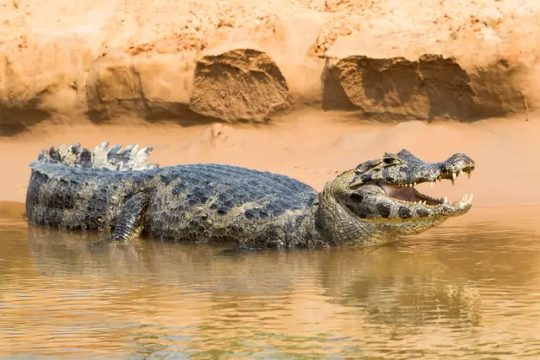
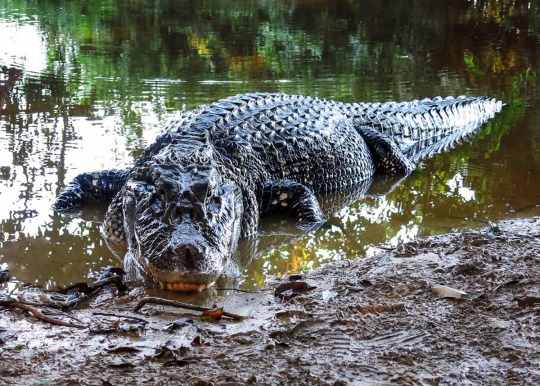
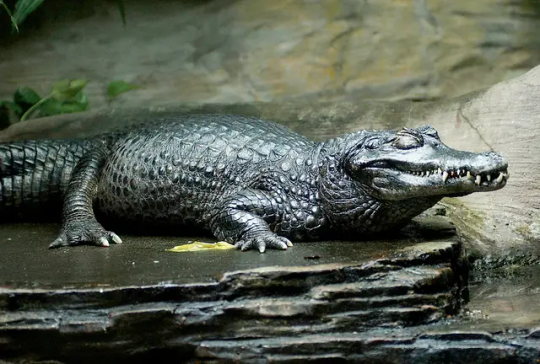
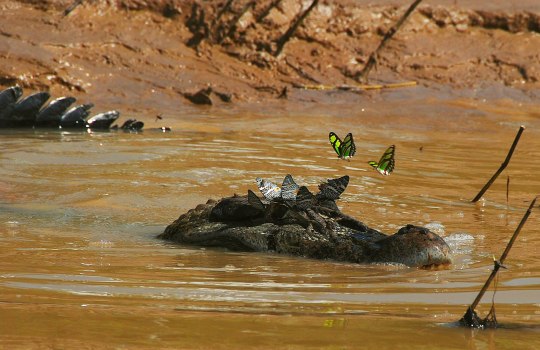
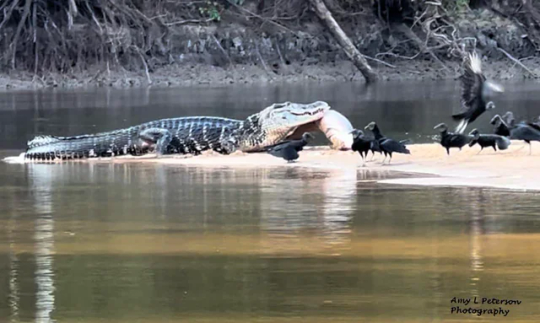
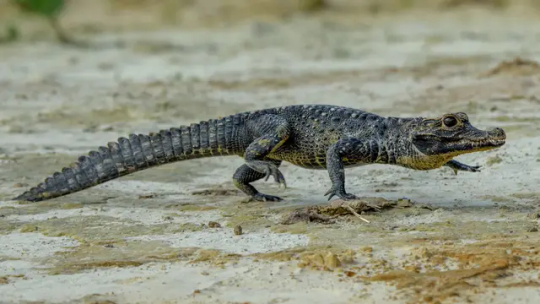
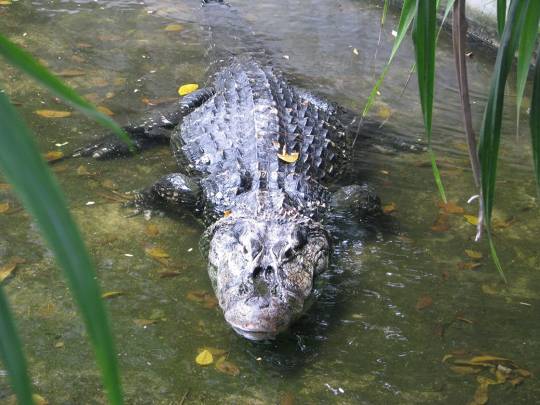

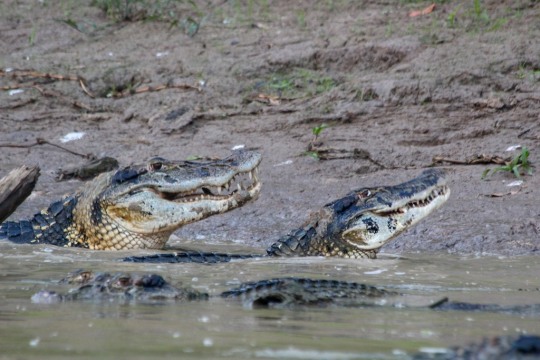
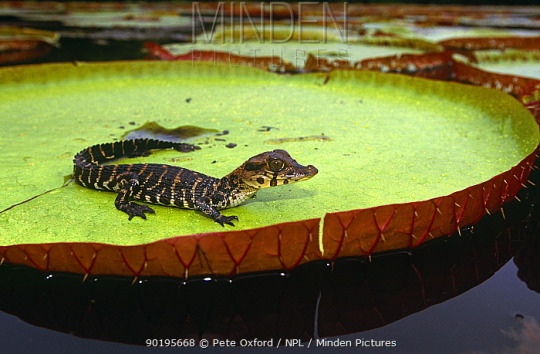
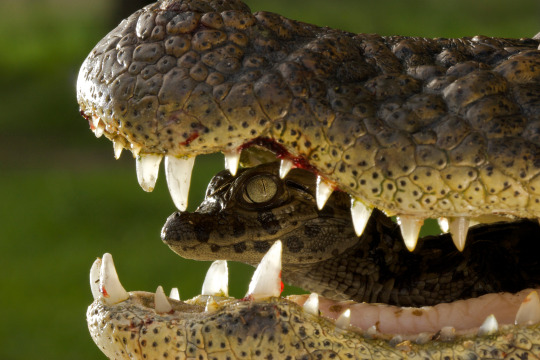

Melanosuchus niger better known as the black caiman is a species of crocodilian which is endemic to the South American countries of Brazil, Ecuador, Peru, Bolivia, French Guinea, and Guyana. Here they largely inhabit rivers, swamps, wetlands, and lakes particularly around the Amazonia. These large semi aquatic ambush predators feed upon fish, invertebrates, amphibians, snakes, lizards, turtles, other crocodilians, various birds, monkeys, sloths, armadillos, rodents, deer, tapir, coati, peccary, cattle, horses, pigs, canines, otters, dolphins, and felines up to the occasional cougar or jaguar. Black caimen are themselves occasionally preyed upon by green anacondas, giant river otters, and jaguars. Most adult black caiman average around 7.3 to 14ft (2.2 to 4.3m) in length and 210 to 770lbs (95 to 350kgs) in weight, however some old and exceptionally large males reaching upwards of 20ft (6.1m) long and 2,400lbs (1,100kgs) are not unheard of. This makes the black caiman not only the largest predator in the amazon, but also the largest caiman, largest member of the Alligatoridae family, one of the largest living crocodilians, and one of the largest reptiles alive today. The black caiman has dark-colored, scaly skin which helps the animal in both camouflage and thermoregulation. The lower jaw has grey to brown banding, and pale yellow or white bands are present across the flanks of the body. Compared to other caiman species, the black caiman is distinctly more robustly built, with a large head, narrow snout, big eyes, and a bony ridge extending from above the eyes down the snout. Breeding occurs near the end of the dry season, during such a time females build nests out of soil and vegetation. Here they lay 30 to 65 eggs which incubate for around 6 weeks. Upon hatching the young will call out to there mother who will help dig them out and carry them to the water in her mouth. She will continue to guard and care for them for several months. Under ideal conditions a black caiman will reach sexual maturity at around 20 years and may live up to 80 years.
#pleistocene pride#pliestocene pride#cenozoic#black caimen#clack caiman#caiman#crocodilian#crocodile#alligator#animal#fact#facts
18 notes
·
View notes
Text

relax, mundie! she's your mama. if that grayface is anything to go by, and from how well you lead your team and take care of us, your mama is a good one.
...
you said your old home is just down the path from here...?
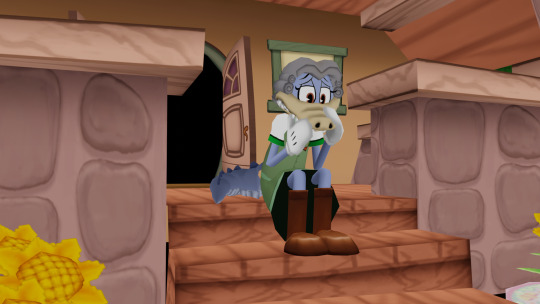
Oh, no... I hope that little deer is okay... I-- I feel... terrible. I know the subject matter in that episode was going to be rough, but... I didn't know it'd hit that close to home with the rest of them...
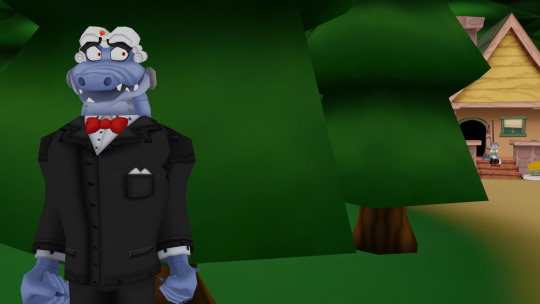
wha-- mundie--!? i... it's okay.... i... i know. i'll. i'll talk to her first. look. it'll be okay. watch!
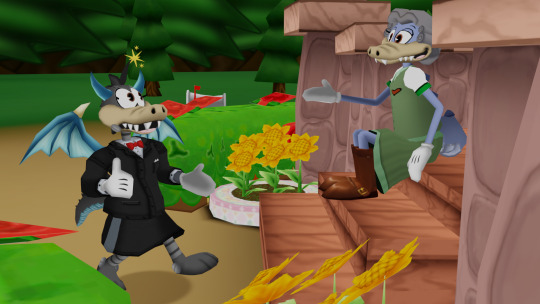
Hm-? Oh, hello, little one, are you lost?
actually, um, you wouldn't happen to be miss mudsnapper, would you?! i'm velma! i saw you on the tv last night!! i um. i have. someone who wants to see you. he's a little scared but he has something important to tell you!! i'll be right back!!
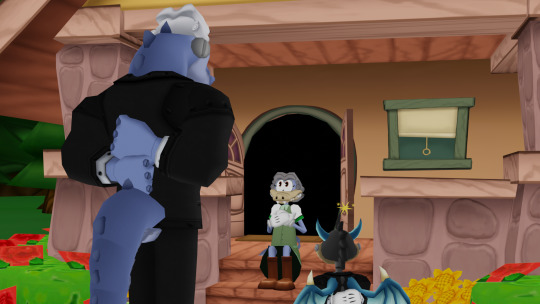
...O-oh my lanta---!! I--
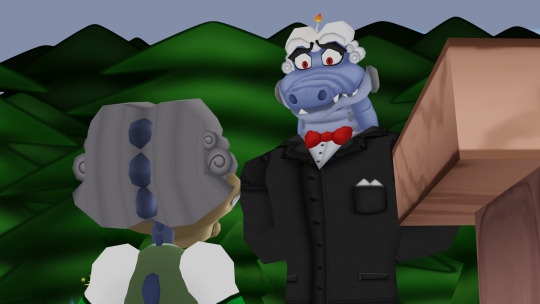
...M-mom? I'm... I'm home. I. I'm sorry-- I.... I just. I was... scared. I. I don't have the heart to tell you what happened to me, e-everything I've been through, w-why I'm a Cog now, h-how badly I missed both of you, all the nightmares, but.
I just.
chirp.
chirp...
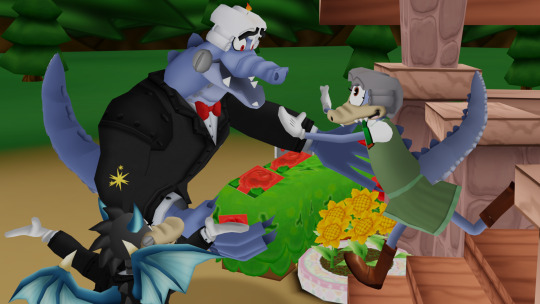
...MY BABY!!!!
#not an ask#mundie.txt#mundie3d#junior litigator on duty!#mama!#velma mudsnapper#muriel mudsnapper#// fun fact! alligators and other crocodilians chirp/squeak#// to communicate with their mamas :)#// i like to imagine toons have unique chirps/squeaks#// so#// anyway YAAAAY he gets to go home and see his mama again !!!
39 notes
·
View notes
Text
Critter fact #99:

Crocodiles can't stick out their tongue. Unfortunately, the swamp puppies can not blep
30 notes
·
View notes
Text

Read the remaining facts, plus myths, quotes, faqs and an epic quiz at: Crocodile Facts
#facts#fun facts#random facts#interesting facts#today i learned#crocodiles#crocodilians#lizards#alligators
2 notes
·
View notes
Text
Have some random gator/croc pics I took today 🐊






16 notes
·
View notes
Text
Uncharismatic Fact of the Day
There’s lots to love about the saltwater crocodile, since they’re the largest living reptile in the world! Males can grow 6m (20ft) long and weigh up to 1,500 kg (3,3000 lbs). The largest specimin was likely over 7 m (23 ft) range, based on the skull currently housed in the Muséum national d'Histoire naturelle in France.

(Image: A saltwater crocodile () out for a swim by David Hancock)
If you like what I do, consider leaving a tip or buying me a ko-fi!
#Saltwater crocodile#crocodilia#Crocodylidae#true crocodiles#crocodilians#reptiles#uncharismatic facts
194 notes
·
View notes
Text










Happy Ice Age Week!
Mekosuchus is a genus of now extinct mekosuchine crocodilian which lived throughout Australia, New Zealand, New Caledonia, Vanuatu, and other Pacific Islands from the Oligocene to Holocene Epochs 28 M.Y.A to 300 A.D. The first known fossils of Mekosuchus consisting of quadratojuagal, a dentary, parts of the skull, and isolated vertebrae were recovered from various different sites across New Caledonia in the early 1980s. These were given to Eric Buffetaut in 1983, who along with Jean-Christophe Balouet properly described them in 1987. Due to the strange anatomy of the material, they initially assumed the animal represented an early eusuchian and placed it in its own family, the Mekosuchidae. Ten years later, in 1997, a second species was described by Paul Willis from the Riversleigh World Heritage Area in Queensland who named the animal M. whitehunterensis. Since then several more specimens have been found and today there are 4 confirmed species: M. whitehunterensis, M. sanderi, M. kalpokasi, & M. inexpectatus. Reaching around 3.3 to 6.7ft (1 to 2m) in length, and 15 to 66lbs (7 to 30kgs) in weight, Mekosuchus is among the smallest mekosuchines. The skull of Mekosuchus was notably short and raised rather than elongated and flattened as seen in most crocodilians. The neck was shortened but strong & flexible. The body was covered in a protective layer of osteoderms. The limbs are notable for almost being more like that of a monitor lizard than other crocodilians, suggesting the mekosuchus would have spent a lot more time on land and would have even been capable of climbing rocks and trees. Some mekosuchus species have teeth designed for stabbing and slicing whilst others have blunter thicker teeth for crushing. In life mekosuchus would have inhabited Rainforests, Swamps, Woodlands, and Coastal Regions where it fed upon Birds, Amphibians, Small Mammals, Other Reptiles, Insects, Crustaceans, and Mollusks: particularly snails.
Art used can be found at the following links
#pleistocene pride#pliestocene pride#pleistocene#pliestocene#cenozoic#ice age week#mekosuchus#arboreal crocodile#crocodile#crocodilian#crocodilians#australia#wildlife#animal#facts#extinct#prehistoric#pacific#new caledonia#vanuatu
1 note
·
View note
Text
Alligator Body Language and You, or: How To Know When An Alligator On Social Media is Being Stressed for Views
Alligators are wild animals. Despite the idiotic claims of animal abusers like Jay Brewer, they cannot be domesticated, which means they are always going to react on the same natural instincts they've had for millions of years. Habituated, yes. Tamed, yes. Trained, definitely. Crocodilians can form bonds with people- they're social and quite intelligent. They can solve problems, use tools, and they're actually quite playful. Alligators are also really good at communicating how they're feeling, but to somebody who doesn't spend much time around them, their body language can be a bit mystifying. And it doesn't help when social media influencers are saying shit like this:

That is not what a happy gator looks like.
That's a terrified, furious gator who isn't attacking because the ogre handling her has her in a chokehold. She's doing everything she can to express her displeasure, and he's lying about it because he knows his audience doesn't even know how to think critically about what he's doing. He knows that because his audience doesn't know anything about these animals, he can get away with it. This I think is why I hate him so much- he deliberately miseducates his audience. He knows what he's doing is factually inaccurate, he just doesn't care because attention means more to him than anything else in the world.
Let's change that! Here are two really important lessons for understanding alligator body language on social media.
Lesson 1: Alligators Don't Smile (in fact, most animals don't)
So what's going on in this video? Jay Brewer is aggressively choking his white alligator Coconut while scrubbing algae off of her with a toothbrush. And make no mistake, he is digging into the creature's throat while she is visibly distressed. He claims she's happy- but she's not. He is willfully misrepresenting what this animal is feeling. That's a problem, because people... well, we actually kind of suck at reading other species' body language. The reason for this is that we tend to overlay our own responses on their physical cues, and that's a problem. For example, let's look at an animal with a really similar face to ours, the chimpanzee. Check out Ama's toothy grin!
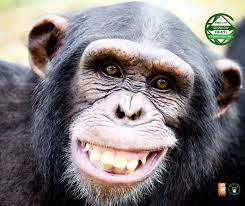
Wait, no. That's not a happy smile. That's a threat display. When a chimpanzee "smiles," it's either terrified and doing a fear grimace, or it's showing you its teeth because it intends on using them in your face.
How about a dog? Look at my smiling, happy puppy!
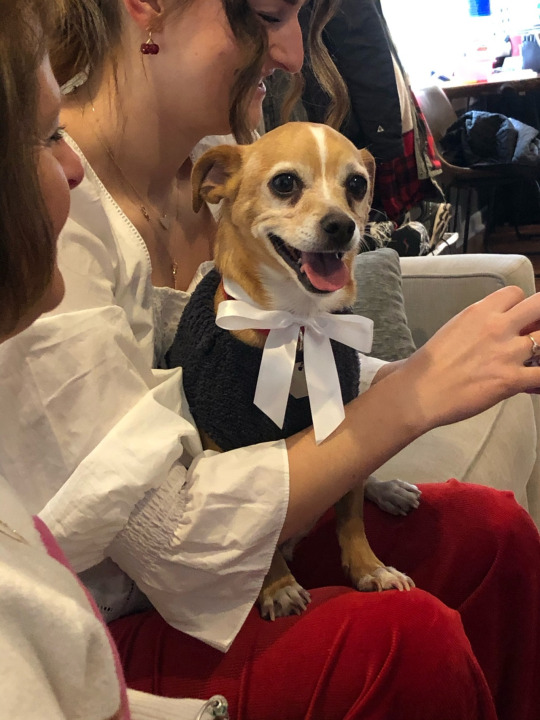
Oh wait no, this is a picture of Ryder when he was super overwhelmed by noise and people during a holiday party. He'd hopped up in my sister's lap to get away from stuff that was happening on the floor and was panting quite heavily. See the tension in the corners of his mouth and his eyes? A lot of the time when a dog "smiles," the smile isn't happy. It's stress! Why Animals Do The Thing has a nice writeup about that, but the point is, our body language is not the same as other species. And for reptiles, body language is wildly different.
For instance, look at these two alligators. Pretty cute, right? Look at 'em, they're posing for a Christmas card or something! How do you think they're feeling?

Well, I'll tell you how the normal one is feeling. He's annoyed! Why is he annoyed? Because the albino just rolled up, pushed another gator off the platform, and is trying to push this guy, too. I know this because I actually saw it happen. It was pretty funny, not gonna lie. He's not gaping all the way, but he was hissing- you can actually see him getting annoyed in the sequence I took right before this shot. Look at him in this first shot here- he's just relaxing, and you can see he isn't gaping even a little bit.
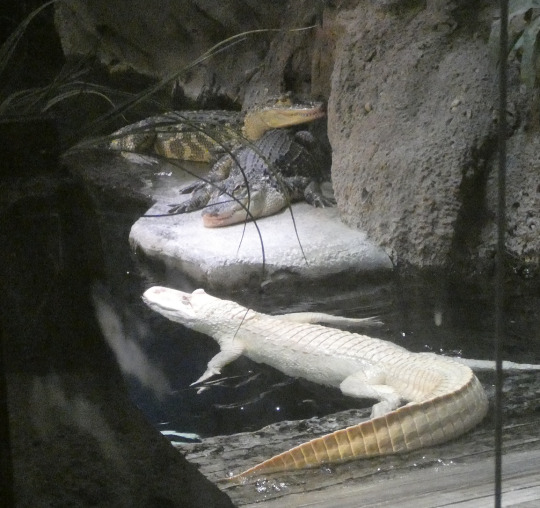

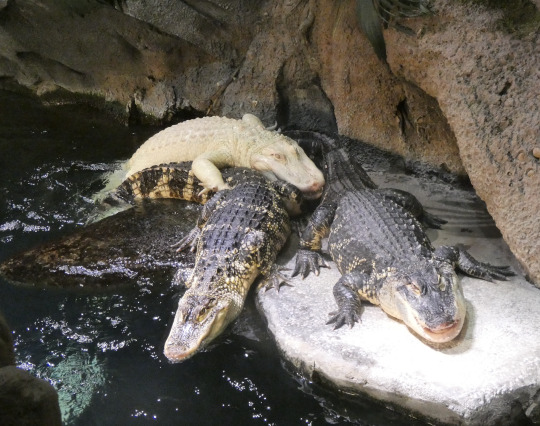
By the end, he's expressing displeasure, but not enough to actually do anything about it. He's annoyed, but he's comfy and that's where one of the best basking areas is, so he'll put up with it.
Reptiles open their mouths wide for a lot of reasons, but never because they are actively enjoying a sensation. Unless they're eating. No reptile smiles- they can't. They don't even have moveable lips. If a reptile is gaping, it's doing so because:
It is doing a threat display.
It is making certain vocalizations, all of which are threats. Alligators are one of the rare reptiles that do regularly vocalize, but most of their calls aren't made with a wide open mouth.
It is about to bite something delicious or somebody stupid. Check out this video- virtually all of the gaping here is anticipatory because these trained gators know darn well that the bowl is full of delicious snacks. (I have some issues with Florida's Wildest, but the man knows how to train a gator AND he is honest about explaining what they're doing and why, and all of his animals are healthy and well-cared for, and he doesn't put the public or his staff at risk- just himself.)
youtube
It's too hot and it has opened its mouth to vent some of that heat and thermoregulate. This is the main reason why alligators will often have their mouths part of the way open, but sometimes they'll open all the way for thermoregulation. This is what a thermoregulatory gape looks like- usually it's not all the way open, kinda more like < rather than V, but you can't say that 100% of the time. Additionally, a thermoregulatory gape... typically happens when it's hot out. If they're inside, maybe they've been under their basking light for too long. Heat's the dominant factor, is what I'm getting at.
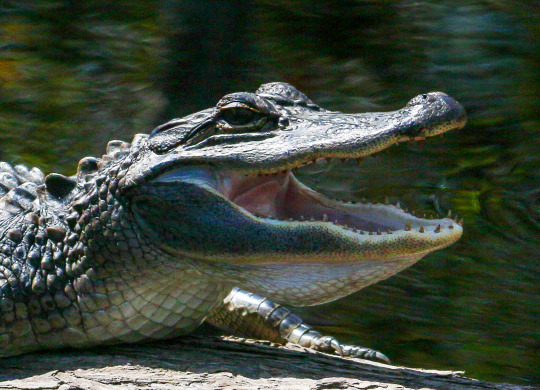
There is another reason that a captive crocodilian might be gaping, and that's because it's doing so on command. Some places have their gators trained to gape on cue, like St. Augustine Alligator Farm and other good zoos. They have the animals do this in presentations that are genuinely educational. They ask the animals to open their mouths so that they can show off their teeth and demonstrate how their tongues seal off the back of their mouth. They'll also do it as part of routine healthcare, because looking at their teeth is important.
In this case, the animals aren't gaping because they're stressed, they're gaping because they know they're gonna get a piece of chicken or fish if they do it. And what's more, they're doing it on cue. They have a specific command or signal that tells them to open wide. It's not an instinctive response to a situation. It's trained. If the animal provides the behavior after a cue, the situation is much less likely to be negatively impactful.
It's also important to remember that there's a difference between a partially open mouth and a gape! As discussed above, alligators will often have their mouths a little bit open just to maintain temperature homeostasis. It helps them stay comfy, temperature-wise. These guys are all doing thermoregulatory open-mouthed behavior- that slight open and relaxed body posture is a dead giveaway. (That and it's the hottest spot in the enclosure.)
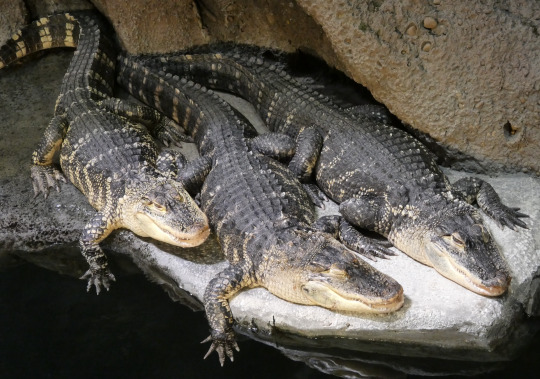
Lesson 2: A Happy Gator Is A Chill Gator
So if alligators don't smile or have facial expressions other than the :V that typically signifies distress, how else can you tell how they're feeling? One way is stillness. See, alligators subscribe to the philosophy of if it sucks... hit da bricks.

Basically, if they hate it, they'll leave. Unless, y'know, somebody has their meaty claws digging into their throat or is otherwise restraining them. (Restraint isn't always bad, btw. Sometimes the animal is going through a medical thing or needs to be restrained for their safety- which a responsible educator will explain.)
Let's look at a very similar scenario, in which a captive alligator is getting his back scrubbed.
As you can see, it's quite different. First, he's not being restrained at all. Second, look at how relaxed he is! He's just chilling there vibing! He could simply get up and leave if he wanted to, because he's not being held. Towards the end of the video, as he lifts his head, you can see that his respiratory rate is very even as his throat flutters a bit. I'm not sure what this facility is, so I can't comment on care/general ethics, but like. In this specific case, this is an alligator enjoying being scrubbed! And you can tell because he's not doing anything. A happy gator is content to be doing what they're doing.
Why Should I Listen To You?
Now, you should ask yourself, why should you listen to me? Why should you trust me, who does not own an alligator, versus Jay Brewer, who owns several?
Well, first off, there's no profit for me in telling you that what you're seeing on social media is in fact not what you're being told you're seeing. I'm not getting paid to do this. That's the thing with people who make social media content. The big names aren't doing it just for fun. They're doing it for money. Whether that's profit through partnerships or sponsorships, or getting more people to visit their facilities, or ad revenue, you can't ignore the factor of money. And this is NOT a bad thing, because it allows educators to do what they're passionate about! People deserve to be paid for the work that they do!
But the problem starts when you chase the algorithm instead of actually educating. A "smiling" alligator gets the views, and if people don't know enough to know better, it keeps getting the views. People love unconventional animal stories and they want those animals to be happy- but the inability to even know where to start with critically evaluating these posts really hinders the ability to spread real information. Like, this post will probably get a couple hundred notes, but that video of Coconut being scrubbed had almost 400,000 likes when I took that screenshot. Think about how many eyeballs that's reached by now. What I'm saying here is that it's just... really important to think critically about who you're getting your information from. What do dissenters say in the comments? What do other professionals say? You won't find a single herpetologist that has anything good to say about Prehistoric Pets, I can tell you that right now.
Another reason you can trust me is that my sources are not "just trust me bro," or "years of experience pretending my pet shop where animals come to die is a real zoo." Instead, here are my primary sources for my information on alligator behavior:
Dragon Songs: Love and Adventure among Crocodiles, Alligators, and Other Dinosaur Relations- Vladimir Dinets
The Secret Social Lives of Reptiles- J. Sean Doody, Vladimir Dinets, Gordon M. Burghardt
Social Behavior Deficiencies in Captive American Alligators (Alligator mississippiensis)- Z Walsh, H Olson, M Clendening, A Rycyk
Social Displays of the American Alligator (Alligator mississippiensis)- Kent Vliet
Social Signals and Behaviors of Adult Alligators and Crocodiles- Leslie Garrick, Jeffery Lang
Never smile at a crocodile: Gaping behaviour in the Nile crocodile at Ndumo Game Reserve, South Africa- Cormac Price, Mohamed Ezat, Céline Hanzen, Colleen Downs (this one's Nile crocs, not American alligators, but it's really useful for modeling an understanding of gape behaviors and proximity)
Thermoregulatory Behavior of Captive American Alligators (Alligator mississippiensis)- Cheryl S. Asa, Gary D. London, Ronald R. Goellner, Norman Haskell, Glenn Roberts, Crispen Wilson
Unprovoked Mouth Gaping Behavior in Extant Crocodylia- Noah J. Carl, Heather A. Stewart, Jenny S. Paul
Thank you for reading! Here's a very happy wild alligator from Sanibel for your trouble.
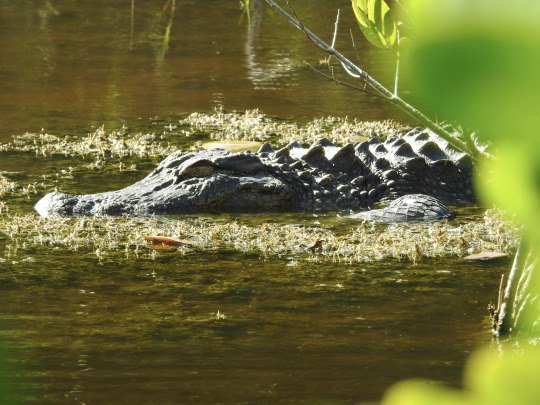
34K notes
·
View notes
Text

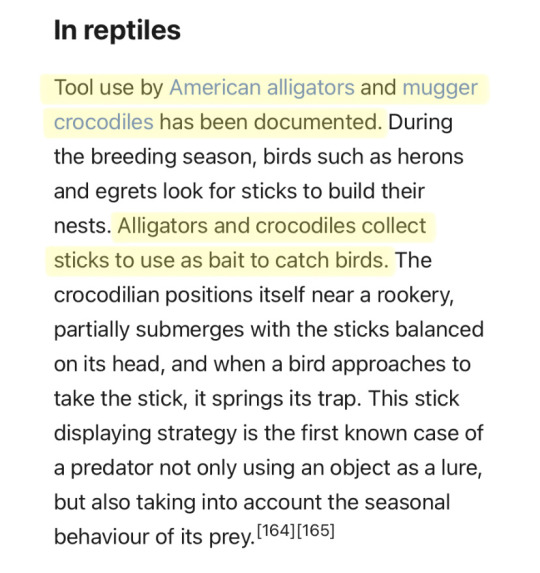
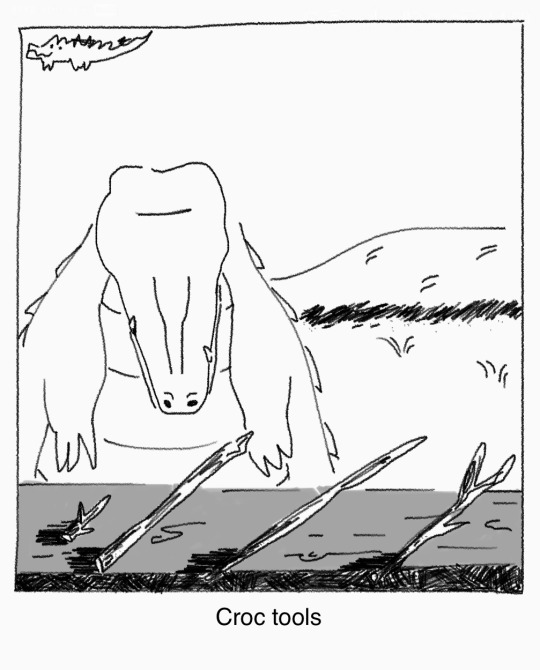
no fucking way
#I didn't want to download the Jurassic Park font so have my freehand version#anyways this is cool#crocodilians#fun animal facts#tool use#clever girls
66K notes
·
View notes
Text
How does one persuade a Gharial to try a vegetarian diet with that snout?
Introduction to the Gharial The gharial, also known as Gavialis gangeticus, is one of the most distinctive and ancient crocodilian species, known for its long, narrow snout filled with sharp, interlocking teeth. Native to the rivers of the Indian subcontinent, this unique reptile has evolved to be an efficient piscivore, primarily preying on fish. The idea of convincing a gharial to switch to…

View On WordPress
#animal fun facts#animal health#animal nutrition#animal persuasion#animal photography#animal training#animal welfare#creative storytelling#creative writing#crocodilian species#dietary habits#endangered species#environmental conservation#exotic animal care#exotic reptiles#fish-eating reptiles#Gharial#Gharial anatomy#gharial conservation#humorous articles#imaginative scenarios#nature in humor#reptile behavior#reptile handling#vegetarian diet#wildlife awareness#wildlife conservation#wildlife education#wildlife humor
0 notes